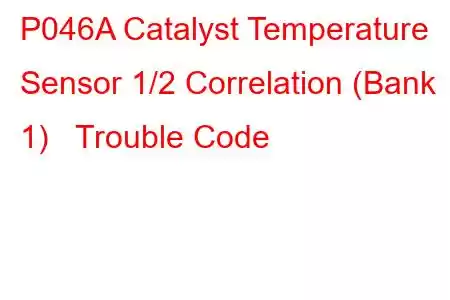P046A Catalyst Temp Sensor Correlation Bank 1
OBD-II Trouble Code Technical Description
Catalyst Temperature Sensor 1/2 Correlation (Bank 1)
What does that mean?
This is a generic transmission diagnostic trouble code (DTC) and applies to OBD-II vehicles with a catalyst temperature sensor. That may include but is not limited to vehicles from Dodge, Ford, Chevrolet, Dodge, Ram, etc. Although generic, the exact repair steps may vary depending on year, make, model and powertrain configuration.
When an OBD-II equipped vehicle has stored a code P046A, it means that the powertrain control module (PCM) has detected a discrepancy between the temperature signals from the catalytic converter of engine bank one. (Bank 1) denotes the bank of the engine which contains the #1 cylinder. So far as I know, only diesel applications utilize catalyst temperature sensors.
Clean burning diesel vehicles require various types of diesel exhaust injections to clear the catalytic converter of harmful emissions. Diesel exhaust fluid (DEF) is injected into the catalytic converter in order to elevate the temperature of the catalyst and burn the nitrogen oxide particles trapped within. These vehicles utilize catalyst temperature sensors (as opposed to oxygen sensors) to monitor catalytic converter efficiency. Using temperature to monitor catalyst efficiency is the most accurate and practical method.
Sensor 1 and Sensor 2 might also be called the upstream and downstream catalyst temperature sensors, respectively. The sensors are typically placed just before and immediately after the catalytic converter in the exhaust system. When the engine is running and warmed up sufficiently, exhaust entering the catalytic converter should be notably cooler than exhaust that is exiting the converter. This is true regardless of the state of the DEF system. The PCM monitors the catalyst temperature sensors constantly and compares the two sensor signals. If the degree of variation between the two is not within a programmed amount, a code P046A will be stored and a malfunction indicator lamp (MIL) may also be illuminated.
What is the severity of this DTC?
Catalyst temperature variation is crucial to reducing exhaust emissions in diesel engines. While this code may be accompanied by no drivability symptoms, from an environmental standpoint, it should be classified as severe.
What are some of the symptoms of the code?
Symptoms of a P046A trouble code may include:
There may be no symptoms with this code Heavy black smoke from exhaust (more than usual) Other DEF and catalytic converter codes Reduced fuel efficiency Increased exhaust emissionsWhat are some of the common causes of the code?
Causes for this P046A transmission code may include:
Defective exhaust temperature sensor Bad catalytic converter DEF system malfunction Burned or otherwise open/shorted circuits in the exhaust temperature sensor systemWhat are some P046A troubleshooting steps?
Were I diagnosing a code P046A, I would like to have a diagnostic scanner, a digital volt/ohmmeter (DVOM), an infrared thermometer (with a laser pointer if possible), and a reputable vehicle information source (such as AllData DIY).
Please ensure that the DEF system is filled with the correct fluid and working properly. If there are DEF related codes present, I would diagnose and repair them before attempting to diagnose a P046A. I would inspect all system related wiring and connectors. Focus on harnesses that are routed near hot exhaust pipes and manifolds.
Connect the scanner to the vehicle's diagnostic port and retrieve all stored codes and freeze frame data. Now, write it down and hang on to it for later. Clear the codes and see if the P046D is reset.
If the code is reset, connect the scanner and observe the data stream with the engine running and at normal operating temperatu
Read: 39


